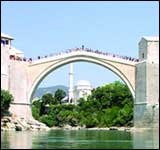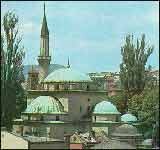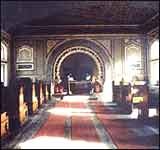JG,SC,MM - Genocide in Bosnia
Bosnian facts
Bosnia declared its independence from the former Yugoslavia in 1992
The ethnic fighting(or genocide) in the western Balkans began shorty after.
Today Bosnia and Herzegovina is the union of two groups; the Muslim-Croat federation and the Bosnian Serb republic.
Bosnia is originally named after the Bosna river.
Official Name: Republic of Bosnia and Herzegovina
Capital: Sarajevo(Population: 434 000)
Other major cities: Banja Luka(Population: 179 200)
Tuzla(Population: 111 900)
Zenica(Population: 104 900)
Major Landmarks:
The Sarajevo Cathedral
The Stari Most Bridge
The Gazi Husrev-beg Mosque
The Ashkenazi Synagogue
Medjugorje
National holiday: National Day, 25 November
Official Currency: Marka (BAM)
Location: Southeastern Europe, bordering the Adriatic Sea and Croatia
Size: slightly smaller than West Virginia(51,129 km²)
Terrain: mainly mountains and valleys, thick forest covers about 50% of the land in the
north, along the Sava River valley, and a hilly, fertile plain stretches from east to
west.
Significant rivers include the Neretua, Sava, Vrbas, and the Bosna.
Climate: hot summers and cold winters short, cool summers and long,
severe winters in areas of high elevation mild, rainy winters along coast
Agriculture: Products: wheat, corn, fruits, vegetables, livestock.
remains mostly in the hands of the owners, but farms have been small and
inefficient.
Industries: Mostly mining and mining-related activities.
Other important industries include steel production, vehicle assembly,
textiles, tobacco products, wooden furniture, and domestic appliances.
Population: 4,025,476 (July 2005 est.)
Languages: Bosnian, Croatian, Serbian
The Bosnian alphabet is derived from the Latin alphabet.
Ethnic groups: Serb 37.1%
Bosniak 48%
Croat 14.3%
other 0.6%
Bosniak replaced Muslim as an ethnic term so it wouldn't be confused with the religious term Muslim
Religions: Muslim 40%
Orthodox 31%
Roman Catholic 15%
other 14% Age structure: 0-14 years: 18.3%
15-64 years: 70.7%
65 years and over: 10.9%
The Bosnia and Herzegovina flag was officially adopted in February, 1998.
Government type: Parliamentary democracy
Legal system: based on civil law system
Right to vote: 18 years of age
The Presidency of Bosnia and Herzegovina changes every eight months among three members. There is one Bosnian, one Serbian and one Croatian, and they are elected for a 4-year term. The Federation votes for the Bosniak and Croat, and the Republika Srpska for the Serb.
Bosnia and Herzegovina was one of the poorer areas in the old Yugoslav Federation and is now one of the poorer countries in Europe.
Sommaire en Français:
La Bosnie a déclaré l`independance du Yugoslave en 1992.
Le nom officielle est: la République de Bosnie et Herzegovina.
La capitale est: Sarajevo (pop: 434 000)
La journée de fête nationale: Journée Nationale (25 novembre)
Argent officielle: Marka
Terrain: Des montagnes et des vallés pour la plupart. Des forêts recouvrent 50% du pays.
Climat: Des étés chauds et des hivers froids.
Population: 4,025,476 (env. juillet 2005)
La Bosnie a déclaré l`independance du Yugoslave en 1992.
Le nom officielle est: la République de Bosnie et Herzegovina.
La capitale est: Sarajevo (pop: 434 000)
La journée de fête nationale: Journée Nationale (25 novembre)
Argent officielle: Marka
Terrain: Des montagnes et des vallés pour la plupart. Des forêts recouvrent 50% du pays.
Climat: Des étés chauds et des hivers froids.
Population: 4,025,476 (env. juillet 2005)







